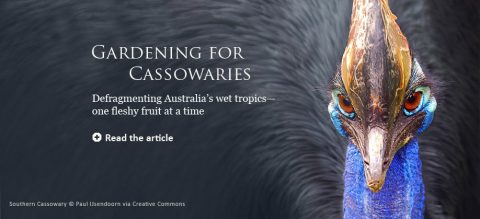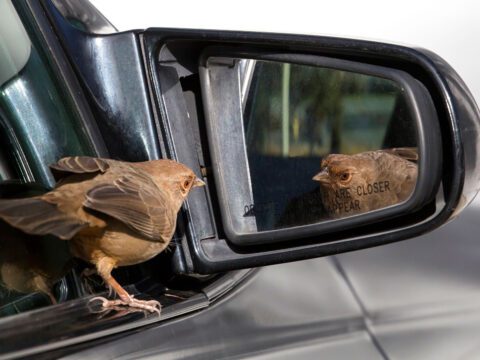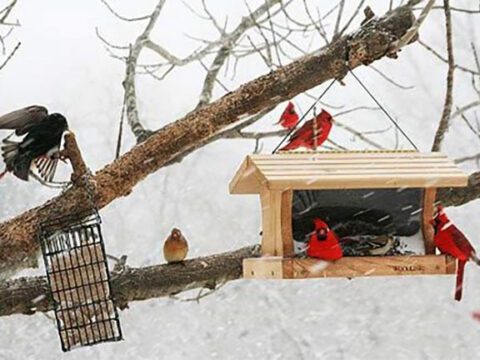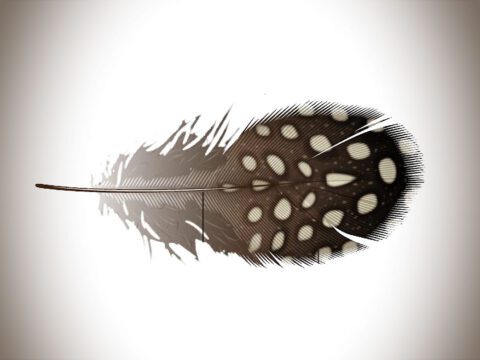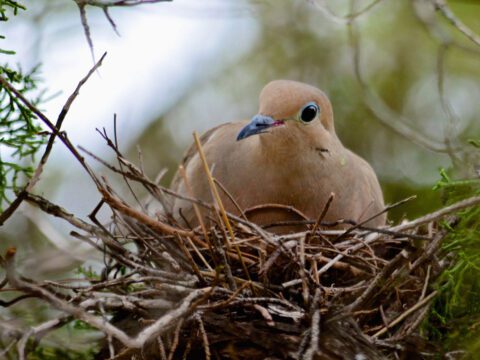Sticking Like a Cocklebur: Pine Warblers and Pines
By Jack Connor, Photo by Melissa Groo
April 15, 2013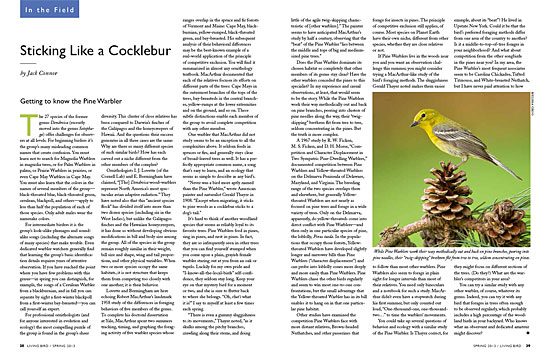
The 27 species of the former genus Dendroica (recently moved into the genus Setophaga) offer challenges for observers at all levels. For beginning birders it’s the group’s many misleading common names that create confusion. You must learn not to search for Magnolia Warblers in magnolia trees, or for Palm Warblers in palms, or Prairie Warblers in prairies, or even Cape May Warblers in Cape May. You must also learn that the colors in the names of several members of the group—black-throated blue, black-throated green, cerulean, blackpoll, and others—apply to less than half the population of each of those species. Only adult males wear the namesake colors.
For intermediate birders it is the group’s look-alike plumages and soundalike songs (including the alternate songs of many species) that make trouble. Even dedicated warbler watchers generally find that learning the group’s basic identification details requires years of attentive observation. If you have reached the point where you have few problems with this genus—in spring you can distinguish, for example, the songs of a Cerulean Warbler from a blackburnian, and in fall you can separate by sight a first-winter blackpoll from a first-winter bay-breasted—you can call yourself an expert.
For professional ornithologists (and for anyone interested in evolution and ecology) the most compelling puzzle of the group is found in the group’s sheer diversity. This cluster of close relatives has been compared to Darwin’s finches of the Galápagos and the honeycreepers of Hawaii. And the questions their success generates in all three cases are the same: Why are there so many different species of such similar birds? How has each carved out a niche different from the other members of the complex?
Ornithologists I. J. Lovette (of the Cornell Lab) and E. Bermingham have claimed, “[The] Dendroica wood-warblers represent North America’s most spectacular avian adaptive radiation.” They have noted also that this “ancient species flock” has divided itself into more than two dozen species (including six in the West Indies), but unlike the Galápagos finches and the Hawaiian honeycreepers, it has done so without developing obvious modifications in bill and body size among the group. All of the species in the group remain roughly similar in their weight, bill size and shape, wing and tail proportions, and other physical variables. When two or more species occupy the same habitats, it is not structure that keeps them from competing too closely with one another; it is their behavior.
Lovette and Bermingham are here echoing Robert MacArthur’s landmark 1958 study of the differences in foraging behaviors of five members of the genus. To complete his doctoral dissertation at Yale, MacArthur spent two summers tracking, timing, and graphing the foraging activity of five warbler species whose ranges overlap in the spruce and fir forests of Vermont and Maine: Cape May, blackburnian, yellow-rumped, black-throated green, and bay-breasted. His subsequent analysis of their behavioral differences may be the best-known example of a real-world application of the principle of competitive exclusion. You will find it summarized in almost any ornithology textbook. MacArthur documented that each of the relatives focuses its efforts on different parts of the trees: Cape Mays in the outermost branches of the tops of the trees, bay-breasteds in the central branches, yellow-rumps at the lower extremities and on the ground, and so on. These subtle distinctions enable each member of the group to avoid complete competition with any other member.
One warbler that MacArthur did not study seems to be an exception to all the complexities above. It seldom feeds in spruces or firs, and generally stays clear of broad-leaved trees as well. It has a perfectly appropriate common name, a song that’s easy to learn, and an ecology that seems as simple to describe as any bird’s.
“Never was a bird more aptly named than the Pine Warbler,” wrote American painter and naturalist Gerald Thayer in 1908. “Except when migrating, it sticks to pine woods as a cocklebur sticks to a dog’s tail.”
It’s hard to think of another woodland species that seems as reliably loyal to its favorite trees. Pine Warblers feed in pines, sing in pines, and nest in pines. In fact, they are so infrequently seen in other trees that you can find yourself stumped when you come upon a plain, grayish female warbler staring out at you from an oak or tupelo. Luckily for my own pride and “I-know-all-the-local-birds” self-confidence, they seldom stay long. Keep your eye on that mystery bird for a moment or two, and she is sure to flutter back to where she belongs. “Oh, that’swhat it is!” I say to myself at least a few times each spring.
“There is even a gummy sluggishness to its movements,” Thayer noted, “as it skulks among the pitchy branches, crawling along their stems, and doing little of the agile twig-skipping characteristic of [other warblers].” The painter seems to have anticipated MacArthur’s study by half a century, observing that the “beat” of the Pine Warbler “lies between the middle and tops of big and medium-sized pine trees.”
Does the Pine Warbler dominate its chosen habitat so completely that other members of its genus stay clear? Have the other warblers conceded the pines to this specialist? In my experience and casual observations, at least, that would seem to be the story. While the Pine Warblers work their way methodically out and back on pine branches, peering into clusters of pine needles along the way, their “twig-skipping” brethren flit from tree to tree, seldom concentrating in the pines. But the truth is more complex.
A 1967 study by R. W. Ficken, M. S. Ficken, and D. H. Morse, “Competition and Character Displacement in Two Sympatric Pine-Dwelling Warblers,” documented competition between Pine Warblers and Yellow-throated Warblers on the Delmarva Peninsula of Delaware, Maryland, and Virginia. The breeding range of the two species overlaps there and elsewhere, but generally Yellow-throated Warblers are not nearly as focused on pine trees and forage in a wide variety of trees. Only on the Delmarva, apparently, do yellow-throateds come into direct conflict with Pine Warblers—and then only in one particular species of pine, the loblolly, Pinus taeda. In the populations that occupy those forests, Yellow-throated Warblers have developed slightly longer and narrower bills than Pine Warblers (“character displacement”) and can probe into loblolly cones more deeply and more easily than Pine Warblers. Pine Warblers chase the other birds regularly and seem to win most one-to-one confrontations, but the small advantage that the Yellow-throated Warbler has in its bill enables it to hang on in that one particular pine habitat.
Other studies have examined the competition Pine Warblers face with more distant relatives, Brown-headed Nuthatches, and other passerines that forage for insects in pines. The principle of competitive exclusion still applies, of course. Most species on Planet Earth have their own niche, different from other species, whether they are close relatives or not.
If Pine Warblers live in the woods near you and you want an observation challenge this summer, you might consider trying a MacArthur-like study of the bird’s foraging methods. The sluggishness Gerald Thayer noted makes them easier to follow than most other warblers. Pine Warblers also seem to forage in plain sight for longer intervals than most of their relatives. You need only binoculars and a notebook for such a study. MacArthur didn’t even have a stopwatch during his first summer, but only counted out loud, “One-thousand-one, one-thousand-two…” to time the warblers’ movements.
You could take up several questions of behavior and ecology with a similar study of the Pine Warbler. Is Thayer correct, for example, about its “beat”? He lived in Upstate New York. Could it be that the bird’s preferred foraging methods differ from one area of the country to another? Is it a middle-to-top-of-tree forager in your neighborhood? And what about competition from the other songbirds in the pines near you? In my area, the Pine Warbler’s most frequent associates seem to be Carolina Chickadee, Tufted Titmouse, and White-breasted Nuthatch, but I have never paid attention to how they might focus on different sections of the trees. (Do they?) What are the warbler’s competitors in your area?
You can try a similar study with any other warbler, of course, whatever its genus. Indeed, you can try it with any bird that forages in trees often enough to be observed regularly, which probably includes a high percentage of the woodland birds in your backyard. Who knows what an observant and dedicated amateur might discover?

All About Birds
is a free resource
Available for everyone,
funded by donors like you
American Kestrel by Blair Dudeck / Macaulay Library
